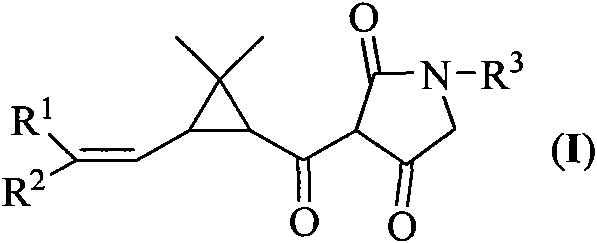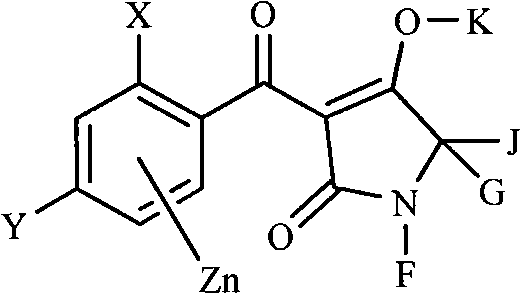3-substituted cyclopropane carbonyl pyrrolidine-2,4-diketone and herbicidal activity thereof
A cyclopropanecarbonyl pyrrolidine, diketone technology, applied in the directions of herbicides, algicides, biocides, plant growth regulators, etc., can solve problems such as no specific records, no compound herbicidal activity, etc.
- Summary
- Abstract
- Description
- Claims
- Application Information
AI Technical Summary
Problems solved by technology
Method used
Image
Examples
Embodiment 1
[0024] Example 1: Synthesis of 1-isopropyl-3-(3-(2,2-dichlorovinyl)-2,2-dimethylcyclopropanyl)pyrrolidine-2,4-dione
[0025] In a 100ml four-necked bottle, 10 mmoles of 3-(2,2-dichlorovinyl)-2,2-dimethylcyclopropanyl ethyl acetate and 15 mmoles of N-isopropylglycine ethyl ester, in Stir and react in 30 ml of benzene at 60°C for 10 hours, then cool to room temperature, add 20 mmol of sodium methoxide solution, and stir at room temperature for 20 hours. After removing the solvent under reduced pressure, the crude product of the target compound was obtained. The pure product was obtained by column chromatography.
Embodiment 2
[0026] Example 2: Synthesis of 1-allyl-3-(3-(2,2-dichlorovinyl)-2,2-dimethylcyclopropaneformyl)pyrrolidine-2,4-dione
[0027] In a 150ml four-necked bottle, 20 mmoles of 3-(2,2-dichlorovinyl)-2,2-dimethylcyclopropanoyl acetate and 30 mmoles of N-allyl glycine ethyl ester, in Stir and react in 70 ml of benzene at 80°C for 12 hours, then cool to room temperature, add 37 mmol of sodium methoxide solution, and stir at room temperature for 20 hours. After removing the solvent under reduced pressure, the crude product of the target compound was obtained. The pure product was obtained by column chromatography.
Embodiment 3
[0028] Example 3. 5-n-butyl-3-(3-(2,2-dichlorovinyl)-2,2-dimethylcyclopropaneformyl)pyrroline-2,4-dione synthesis
[0029] In a 50ml four-necked bottle, 20 mmoles of 3-(2,2-dichlorovinyl)-2,2-dimethylcyclopropanoyl acetate and 30 mmoles of 3-n-butylglycine ethyl ester hydrochloride salt, stirred and reacted at 80°C in 20 ml of benzene for 34 hours, cooled to room temperature, added 21 mmoles of sodium methoxide solution, and stirred at room temperature for 20 hours. After removing the solvent under reduced pressure, the crude product of the target compound was obtained. The pure product was obtained by column chromatography.
PUM
 Login to View More
Login to View More Abstract
Description
Claims
Application Information
 Login to View More
Login to View More - R&D
- Intellectual Property
- Life Sciences
- Materials
- Tech Scout
- Unparalleled Data Quality
- Higher Quality Content
- 60% Fewer Hallucinations
Browse by: Latest US Patents, China's latest patents, Technical Efficacy Thesaurus, Application Domain, Technology Topic, Popular Technical Reports.
© 2025 PatSnap. All rights reserved.Legal|Privacy policy|Modern Slavery Act Transparency Statement|Sitemap|About US| Contact US: help@patsnap.com



